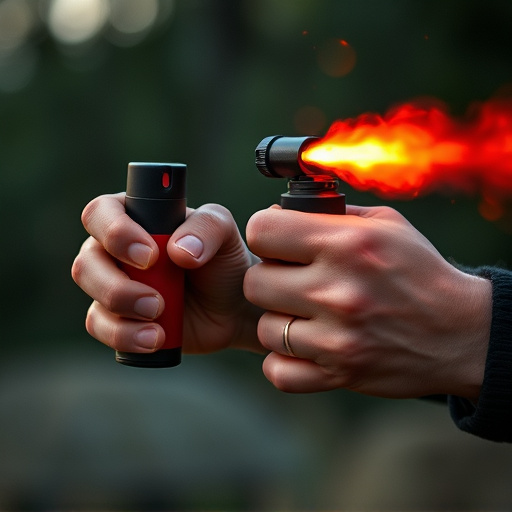Capsaicin, the key ingredient in chili peppers, is a potent inflammatory agent that makes low light pepper spray a valuable self-defense tool. In reduced visibility conditions, pepper spray blinding effects and temporary immobilization capabilities give users an advantage over attackers, allowing for safer deployment at closer ranges or from cover. Effective tactics include hand signals, targeted aiming at vulnerable areas, protective gear, distance maintenance, ventilation, and regular practice in simulated low light scenarios. "Low Light Pepper Spray Tactics" are crucial for nighttime encounters and dimly lit public spaces, enhancing personal safety while minimizing risk to users and bystanders.
“Unveiling the power of capsaicin, a natural inflammatory agent, as an innovative deterrent in low light conditions, this article explores the strategic deployment of capsaicin spray for self-defense. With a focus on ‘Low Light Pepper Spray Tactics’, we delve into the science behind capsaicin’s effectiveness, its ideal environment in dimly lit scenarios, and essential safety measures during application. Understanding these factors is key to harnessing the potential of this unique non-lethal weapon.”
- Understanding Capsaicin and Its Inflammatory Properties
- Low Light Conditions: The Ideal Environment for Pepper Spray Tactics
- Effective Application and Safety Measures for Capsaicin Spray in Limited Visibility
Understanding Capsaicin and Its Inflammatory Properties
Capsaicin, the active ingredient in chili peppers, is a powerful compound with notable inflammatory properties. When used in low light pepper spray tactics, its effects are both deterrents and debilitating. In low-light environments, where visibility is limited, capsaicin spray can create a significant disadvantage for potential assailants due to its ability to cause severe irritation and pain.
The inflammatory nature of capsaicin leads to a range of physiological responses when it comes into contact with mucous membranes and skin. This includes increased heart rate, breathing difficulties, and intense burning sensations. In the context of low light pepper spray, these effects can immobilize an attacker momentarily, providing crucial time for escape or intervention. Understanding capsaicin’s mechanism of action highlights its potential as a strategic self-defense tool in situations where traditional lighting might be compromised.
Low Light Conditions: The Ideal Environment for Pepper Spray Tactics
In low light conditions, pepper spray becomes an even more effective deterrent and tactical tool for personal safety. This is because visibility is reduced, making it harder for potential assailants to identify and target their victim. The blinding effect of pepper spray in such environments amplifies this disadvantage, creating a critical moment of disorientation for the attacker.
With its ability to temporarily incapacitate through irritation and pain, low light conditions provide an ideal environment for pepper spray tactics. The reduced visibility means that an individual can deploy the spray at closer ranges or even from behind cover, increasing their chances of neutralizing a threat without endangering themselves or bystanders in well-lit areas. This makes it an indispensable tool for personal protection, especially during nighttime encounters or in dimly lit public spaces.
Effective Application and Safety Measures for Capsaicin Spray in Limited Visibility
In low light or limited visibility conditions, effective application of capsaicin inflammatory agent deterrent spray requires specific tactics to ensure safety and optimal efficacy. Users should employ hand signals or use a partner for direction, as aiming in dim light can be challenging. It’s crucial to target areas like the eyes, nose, and mouth, where capsaicin is most effective in causing discomfort and deterring an assailant.
Safety measures are paramount when using capsaicin spray in low light scenarios. Users should wear protective gear, including gloves and eye protection, to avoid accidental exposure. Additionally, maintaining a safe distance and ensuring proper ventilation are essential, as the spray’s effects can be exacerbated by poor air quality or close proximity. Regular practice of application techniques in simulated low-light conditions can greatly enhance an individual’s ability to use capsaicin spray effectively while minimizing risk.
Capsaicin, the active ingredient in pepper spray, offers a powerful deterrent in low light conditions due to its unique inflammatory properties. Understanding how this agent interacts with the body’s response to irritants is key to effective deployment. By leveraging low light environments, individuals can maximize the impact of capsaicin sprays for personal safety. However, proper application techniques and safety measures are essential to ensure the spray’s effectiveness while minimizing risks associated with its use. Adhering to best practices for capsaicin spray in limited visibility situations will help users stay safe and secure in challenging conditions.
